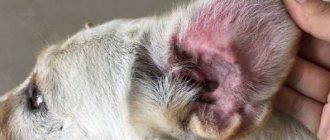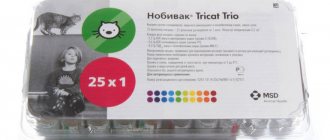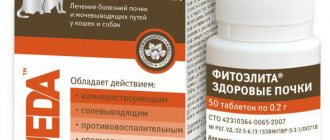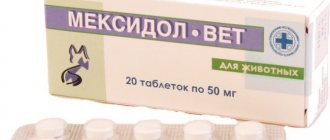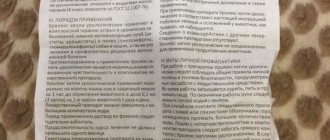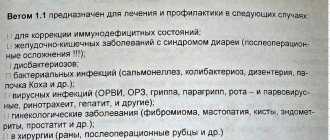general description
Ivermek is available in pharmacies in the following dosage forms:
- injection solution;
- gel;
- spray.
The solution is used for injections, and the aerosol and gel are used for external treatment. And although the dosage forms are used in different ways, the active substance in them is the same. The antiparasitic effect is due to the presence of ivermectin in the composition.
The injection solution has the appearance of a transparent, colorless or light yellow liquid. Glass bottles of various capacities are usually used for packaging. Pharmacies most often sell containers of 20 and 100 ml. For cats, it is worth purchasing small bottles, since the medicine can only be stored for 42 days after opening the package. Purchasing a large bottle for small animals can be a waste of money.
The spray is available as a colorless liquid, although a light yellow tint may be present. To package medicinal liquid intended for external use, bottles with spray heads are used. Thanks to them, the drug is easy to use.
The gel is made on a water basis. Externally it has a light yellow color. Packaged in polymer tubes. They can hold 10,20 or 30 ml. There is no need to observe special storage conditions, but after opening the package, the drug is suitable for use only for 60 days. Since the medicine cannot be used after this period, it is better to put a sticker with the date of opening.
Description of the drug "Ivermek"
Ivermek is produced in three forms: solution, gel and spray.
The composition of the product is the same in all three forms. However, the active component of the injection enters the circulatory system and is thereby distributed throughout the body, while in a spray or gel the action is directed more towards external parasites, which must be taken into account when selecting treatment. The active substance ivermectin acts on the nerve cell of parasites, paralyzing and killing them. At the same time, the product is absolutely harmless to the cat itself. It acts on ticks, fleas and roundworms that disrupt the cat’s digestive system. Vitamin E (tocopherol) included in the solution improves the absorption of the medicine and supports the normal functioning of organs, panthenol and chlorhexidine in the gel and spray accelerate healing, and lidocaine anesthetizes.
The solution for injection has a clear or light yellowish color and is odorless, which makes it easy to use. The solution is packaged in ampoules of 1, 10, 20, 50 and 100 ml. Large volumes can be purchased individually (but not worth it), and the smallest volume starts from 50 ampoules. The colorless spray is available in bottles with a special sprayer. Volumes – 25, 50, 100, 125, 150, 200, 250, 300 and 350 ml. The light yellow gel is sold in tubes of 10, 20 and 30 ml.
pharmachologic effect
Ivermec contains ivermectin, which has an antiparasitic effect. It applies to almost all types of ectoparasites (ticks, fleas, etc.), as well as roundworms that parasitize the gastrointestinal tract and other organs. The effectiveness of ivermectin is due to the fact that the substance affects the nervous and muscular systems, so the parasites have no chance of survival.
When using an injection solution, the active substance penetrates the bloodstream, and with it through all organs and tissues of the animal. The therapeutic effect lasts 10-14 days. The injection solution also contains tocopherol or vitamin E. It improves the absorption of the main component and accelerates its distribution throughout organs and tissues.
Important! The active component is considered a very toxic and dangerous substance. In Ivermek its concentration is low, so the drug is classified as safe for animals. To prevent it from harming the animal, the dosage must be strictly observed.
When using a spray or gel, the active component does not penetrate into the blood, but remains on the surface of the skin, so they are used only to combat external parasites. These dosage forms also contain panthenol or panthethonic acid production. These substances improve tissue regeneration. They not only accelerate the healing of the skin, but also have an anti-inflammatory effect.
The gel and aerosol also contain lidocaine. This is a local anesthetic. It suppresses pain well and also has an antipruritic effect. When using Ivermek for external treatment, not only parasites are destroyed, but also unpleasant symptoms are eliminated. The spray additionally contains chlorhexidine, which has anti-inflammatory and antibacterial effects. Thanks to this substance, the risk of developing complications in the form of inflammatory and purulent processes is reduced.
Pharmacological properties
The active ingredient of Otodectin is ivermectin. It is highly active against larvae and mature individuals of round and cestode helminth worms, lice (Trichodectes canis), lice (Linognathus setosus), various types of ticks (Otodectes cynotis, Sarcoptes spp. and others). Otodectin changes the permeability of membranes in the cells of the parasite, disrupts the conduction of impulses along nerve fibers, thereby becoming the cause of its death.
Otodectin is quickly absorbed into the blood and is excreted from the animal’s body with bile and urine. Penetrates into the breast milk of nursing cats.
Instructions for use of the drug in veterinary medicine characterize Otodectin as an antiparasitic agent that eliminates the threat in the form of:
- nematodes;
- demodectic and sarcoptoid mites;
- insects that parasitize carnivores.
Important! It is strictly not recommended to use the medicine for anthelmintic treatment of puppies and kittens under 2-3 months of age.
The active element of the drug affects the elastic membranes of the nerve and muscle cells of the parasitic organism and destroys chlorine ions. With this action, paralysis occurs and, as a result, harmful inhabitants, organisms that live on the pet, die. After injection, the effectiveness of the drug lasts up to 12 hours, after which all final substances are excreted from the body with bile and urine. In lactating individuals, such substances may be excreted along with milk.
Did you know? Cats have remarkable memory. While a dog's memory lasts only a few minutes, a cat's memory can retain information for up to 15 hours. Such indicators can only be compared with the memory of an orangutan.
Ivermectin has a pronounced antiparasitic effect with a wide spectrum of activity against the larval and mature stages of round helminths, ectoparasites of carnivores: Otodectes cynotis, Sarcoptes spp., Notoedres cati, Psoroptes cuniculi, Cheyletiella jascuri, Linognathus setosus, Trichodectes canis, Ctenocephalides spp.
The mechanism of action of ivermectin is its effect on the current of chloride ions through the membranes of nerve and muscle cells of the parasite. The main targets are glutamate-sensitive chloride channels, as well as gamma-aminobutyric acid receptors. A change in the current of chlorine ions disrupts the conduction of nerve impulses, which leads to paralysis and death of the parasite.
When to use
The injection solution is used for cats with helminthic infestations caused by roundworms:
- with toxascariasis;
- with toxaridosis;
- with hookworm;
- with uncinariasis.
All dosage forms of Ivermek are used for external parasites. The medication is successfully used to treat the following pathologies:
- notoedrosis;
- demodicosis;
- otodectosis;
- sarcoptic mange;
- psoroptosis.
For cats, the drug is used only for medicinal purposes. For prevention, it is worth choosing a less toxic medicine.
Indications for use
The injection solution eliminates all types of external parasites, as well as the following pathologies caused by nematodes:
- toxascariasis;
- intestinal gadfly;
- uncinariasis;
- hookworm.
In the form for external use, Ivermek is effective only against the following lesions:
The drug is not used for prophylactic purposes. It is used exclusively as a medicine for severe damage, when other formulations are not effective enough.
How to use
The use of the drug directly depends on its dosage form. Before use, you should consult a doctor to avoid possible side effects and complications.
Injections
Injections of the antiparasitic agent should be done intramuscularly, preferably into the thigh of the hind paw. For injections, insulin syringes with a thin needle should be used. When using the injection solution, it is necessary to follow the rules of asepsis. Be sure to use sterile syringes and treat the injection site with medical alcohol. Usually one injection is enough to completely get rid of parasites, but if the infection is severe, a second injection may be necessary after 10 days.
The dosage of the drug is calculated as follows: for every 10 kg of weight you need 0.2 ml of solution. It is important not to exceed the dose. Since it is quite difficult to calculate the exact dose for small animals, the solution is diluted with water for injection.
Since ivermectin is highly toxic, it can have a negative effect on the liver. To prevent possible negative consequences, hepatoprotectors or herbal-based liver medications are additionally prescribed.
Spray and gel
Treatment of an animal in the presence of ticks, fleas and other ectoparasites is carried out in the following sequence:
- Clean the affected areas from scabs and crusts. For these purposes, a special cleansing lotion can be used.
- Next, apply a thin layer of the medicine. The aerosol should be sprayed at a distance of 10-15 cm from the skin. Do not spray the spray in the eye and mouth area. The medicine should be applied to the fingers wearing a rubber glove, and then rubbed into the affected areas.
- Along the edges you need to capture 1-2 cm of healthy skin.
- A cervical collar must be put on the animal so that it cannot lick the medicinal composition. Ingestion of the drug is strictly prohibited. If there is no collar, then you should hold your pet until the medicine dries (is absorbed).
The instructions for use indicate that the dosage of Ivermek spray and gel is 0.2 ml per 1 kg of weight. Usually the procedure is repeated several times with an interval of 3-5 days. If the mite damage is extensive, then the treatment is carried out in two stages: one day the drug is applied to one side, and only the next day - to the other side. Using this treatment regimen, it will be possible to avoid an overdose of the drug.
For otodectosis, a spray or gel is applied to the ear canals on both sides. They are first cleaned of scabs. If the disease is complicated by otitis media, anti-inflammatory and antibacterial agents are additionally used.
How and in what dosage to use the drug
Since the drug is prescribed to combat parasites that torture the animal from the inside, according to the instructions, the drug is used in the form of intramuscular injections. The instructions for cats establish acceptable dosage values for the drug, which directly depend on the weight of the animal, at a rate of one tenth of a milliliter per five kilograms of weight. For the purpose of prevention, one injection may be quite enough, but if we are talking about treatment, the injection should be given every ten or fourteen days, depending on the complexity of the disease.
This two-week period between injections is provided as a precautionary measure to avoid an overdose of the drug. Otherwise, an overdose can cause intoxication of the body, and even death.
In order to remove excess drug from the animal’s body, it is necessary to administer a large amount of fluid and diuretics.
To the question “Where should I inject the drug?” There are two answer options, the first of which is at the withers, the second option is at the knee fold. In both the first and second cases, it is recommended that the injection be given by an experienced specialist himself or under his direct supervision and control.
The drug has a wide spectrum of action, this means that it is also applicable to dogs to combat various ailments. They can be treated with injections and gel, which is sold in tubes. The gel is intended for external use. It is recommended for use two to four times at intervals of five or seven days to avoid overdose. It is actively used to treat lichen in dogs. The gel contains components such as panthenol (promotes rapid healing of wounds and various types of fungal formations on the skin) and lidocaine (has anesthesia properties). Moreover, the gel prevents itching. The main advantage of the gel is that the drug is not absorbed into the blood, but accumulates on the surface of the skin, providing a therapeutic effect lasting five to seven days.
Contraindications and side effects
According to the instructions, Ivermek is not used for weakened and sick cats. Its use is also contraindicated in the following cases:
- during pregnancy;
- when feeding offspring;
- for infectious diseases;
- in case of intolerance to components.
It is strictly forbidden to use antiparasitic medicine on kittens under 12 weeks of age. If you have liver diseases, consult a doctor.
If the dose is not exceeded, Ivermek is well tolerated by animals. In case of overdose, the following symptoms may occur:
- increased saliva production;
- tearfulness;
- vomit;
- muscle tremors.
Spontaneous urination and bowel movements may also occur when using the solution. There is no need to take special measures, but further use of the drug is canceled.
Contraindications
It is prohibited to give Ivermek to a kitten that is less than 12 weeks old, and the product should not be used in the following cases:
During the period of feeding offspring, females cannot be treated with this drug.
- pregnancy in a cat;
- feeding kittens with milk;
- diseases of infectious origin;
- liver pathologies;
- individual intolerance to the components of the drug.
Owner reviews
Marina, volunteer:
“Most people pass cats on the street that are covered in scabs and the animals are meowing and asking for help. I am part of a group of volunteers in our city. To treat scabies in cats and dogs, we have been using Ivermec solution for a long time. An excellent tool. It is inexpensive, but in just 2 injections it helps rid the animal of parasites. The fur grows back quickly."
Alla, owner of the Scottish cat:
“We were prescribed Ivermec for demodicosis. The cat turned out to be intolerant to the drug. After 2 hours, severe vomiting began and continued until the evening. The money spent had to be thrown in the trash, and the veterinarian selected another medicine for treatment.”
Instructions for use
Ivermek instructions for use for cats indicate that the drug can be used in various ways:
- Intramuscularly.
- Externally.
It is not recommended to choose a specific form of medication on your own. The decision about which type of this remedy will be most effective in each specific case must be made by the veterinarian.
Injections are made using the solution (preferably into the withers or thigh). In case of moderate parasite infestation, the drug is administered once. In severe cases, several injections will be required, with breaks of 7-10 days. For preventive purposes, the injection is given in the spring, once during the year.
Before topical application of the product (applying gel or spraying), areas of the animal’s skin affected by parasites are thoroughly cleaned of debris, tangled hair, and crusts. Next, the drug is evenly distributed over the skin. The procedure is repeated 3-4 times during the day. The duration of treatment is determined individually by a specialist. On average it takes from 3 to 10 days.
Range of actions
The drug has a wide spectrum of action, copes with skin diseases, including those caused by parasites (lice, mites), as well as parasites that penetrate inside the body. The product is eliminated naturally and does not have a toxic effect on the pet. Ivermek is prescribed in the following cases:
- ascariasis;
- hookworm (helminthiasis of the lungs and gastrointestinal tract);
- lice;
- demodicosis (skin disease);
- mallophagosis (parasitic);
- otodectosis (ear parasite);
- for scabies in dogs, psoroptosis (caused by mites);
- strongyloidiasis (caused by an intestinal parasite);
- trichocephalosis (parasitic);
- Thelaziosis (eye nematodes);
- estrosis (parasite in the nasopharynx and subcutaneous).
The drug contains ivermectin (an extract of a fungus from the genus Streptomycetes) - 10 mg, tocopherol acetate (helps remove toxins from the body) - 40 mg, auxiliary elements: dimethylacetamide, benzyl alcohol and water.
Composition and mechanism of action of the drug
Regardless of the form of release, the main substance of the medicine is ivermectin in combination with vitamin E. External agents are supplemented with components such as lidocaine, dexpanthenol, Cremophor RH 410.
Ivermectin is produced by fermentation of the fungus Streptomyces avermitilis. It is used in veterinary medicine as an antiparasitic agent used against fleas, ticks, other ectoparasites and helminths. After using the medicine, the electrical conductivity of chlorine ions changes, which blocks the flow of nerve impulses. The result is paralysis and death of the parasites.
Lidocaine contained in the spray and gel helps relieve itching and pain, and dexpanthenol promotes wound healing. Cremophor RH 410 is added to the external product in order to make the consistency denser. This allows you to increase the period of action of the product. The spray is supplemented with chlorhexidine digluconate, which has a disinfectant and anti-inflammatory effect.
After intramuscular administration, the active substance quickly spreads throughout the animal’s body, penetrating into organs and tissues. The antiparasitic effect lasts for 2 weeks. This period is sufficient to destroy both mature individuals and larvae of insects and helminths.
Method of using the product in different forms
- clean the affected skin surfaces from scabs;
- put a spray nozzle on the bottle;
- spray the product several times at a distance of up to 20 cm until the entire affected surface is wet (during treatment, you should also include some of the uninfected skin and fur).
If the product needs to be applied to the nose or around the eyes, this should be done with your fingers. If your cat has long hair, you can use a comb for convenience. After the procedure, you should put a special collar on the cat and keep it until the spray dries to prevent licking off the active substance.
When using a gel product, apply a thin layer to the cleansed skin and hair of your pet. For ear mites, the gel is placed in the ear. After this, the pet’s ear should be folded in half and massaged closer to the head. Until the product dries, you should put on the cat an Elizabethan collar (see photo). It is necessary to apply the gel to the affected areas twice, after a pause of 7 days. The maximum number of applications is 6 times. A single dosage of the gel is 0.3 ml per 1 kg of cat weight for sarcoptic mange, demodicosis, notoedrosis and 0.5–2 ml for ear mites.
Do not smoke, eat or drink while your cat is being treated with the gel or given an injection. After the procedure, wash your hands thoroughly with soap. If the product gets on your skin or eyes, rinse them with plenty of water.
Reviews about the drug from dog owners and veterinarians
The drug really has a strong toxic effect not only on parasites, but also on pets, so it is very important to follow all the rules of use and follow the veterinarian’s recommendations. Reviews are mixed, the medicine is really strong, but the side effects and possible threats scare dog breeders.
- Christina (dog breeder):
“We have 2 dogs and use flea and tick spray regularly. An excellent drug, easy to use, no side effects, it’s just important to follow the dosage.”
- Svetlana (dog breeder):
“We have a St. Bernard, we brought him from the village and caught a bunch of worms. The vet prescribed Ivermec. Two injections were enough, of course, and at the same time we took pills to support the liver. Now the tests are fine.”
- Ekaterina (dog breeder):
“Injecting Invermec for demodicosis did not help our Bull Terrier, we will contact another clinic, although perhaps the dose was simply not suitable.”
Customer reviews from forums:
The drug is convenient because it has a wide spectrum of action and kills all parasites that harm the pet. However, it also has plenty of disadvantages. Firstly, it is difficult to determine the required dose, and secondly, there are many contraindications. The medication should not be used for small dogs and even for large breeds it should be used carefully. One way or another, the last word is always with the owner.
